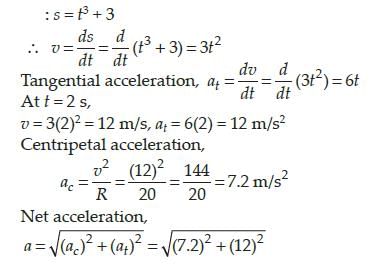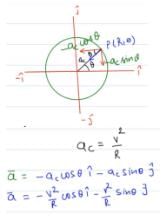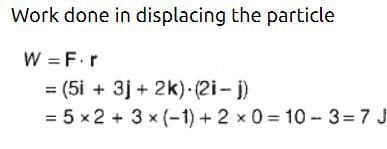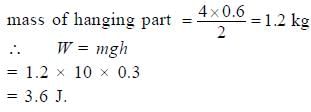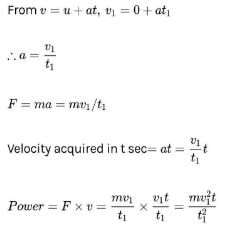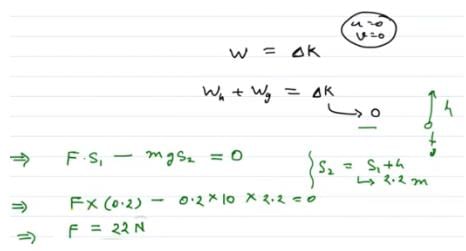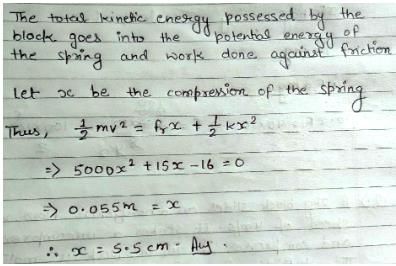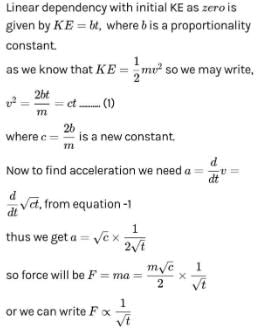Test: NEET Previous Year Questions: Work, Energy & Power - 1 - NEET MCQ
22 Questions MCQ Test - Test: NEET Previous Year Questions: Work, Energy & Power - 1
The minimum velocity (in ms-1) with which a car driver must traverse a flat curve of radius 150 m and coefficient of friction 0.6 to avoid skidding is
[AIEEE 2002]
Which of the following statements is false for a particle moving in a circle with a constant angular speed ?
[AIEEE 2004]
An angular ring with inner and outer radii R1 and R2 is rolling without slipping with a uniform angular speed. The ratio of the forces experienced by the two particles situated on the inner and outer parts of the ring, F1/F2 is
A point P moves in counter-clockwise direction on a circular path as shown in the figure. The movement of P is such that it sweeps out a length s = t3 + 5, where s is in metre and t is in second. The radius of the path is 20 m. The acceleration of P when t = 2s is nearly
[AIEEE 2010]
For a particle in uniform circular motion the acceleration at a point P(R,) on the circle of radius R is (here
is measured from the x-axis)
[AIEEE 2010]
In a typical power station, amid a series of energy transfers and conversions, about 70% of energy input gets wasted in form of thermal energy, efficiency of such a power station is about
A spring of force constant 800 N/m has an extension of 5 cm. The work done in extending it from 5 cm to 15 cm is
[AIEEE 2002]
A body is moved along a straight line by a machine delivering a constant power. The distance moved by the body in time t is proportional to
[AIEEE 2003]
A spring of spring constant 5 × 103 N/m is stretched initally by 5 cm from the unstreched position. Then the work required to stretch it further by another 5 cm is
[AIEEE 2003]
A force F = (5i + 3j +2 k) N is applied over a particle which displaces it from its origin to the point r = (2 i - j) m. The work done on the particle in joule is
[AIEEE 2004]
A uniform chain of length 2 m is kept on a table such that a length of 60 cm hangs freely from the edge of the table. The total mass of the chain is 4 kg. What is the work done in pulling the entire chain on the table?
[AIEEE 2004]
A particle moves in a straight line with retardation proportional to its displacement. Its loss of kinetic energy for any displacement x is proportional to
[AIEEE 2004]
The block of mass M moving on the frictionless horizontal surface collides with the spring of spring constant k and compresses it by length L. The maximum momentum of the block after collision is
[AIEEE 2005]
A spherical ball of mass 20 kg is stationary at the top of a hill of height 100 m. It rools down a smooth surface to the ground, then climbs up another hill of height 30 m and finally rolls down to a horizontal base at a height of 20 m above the ground. The velocity attained by the ball i
[AIEEE 2005]
A body of mass m is accelerated uniformly from rest to a speed V in a time T. The instantaneous power delivered to the body as function of time, is given by
[AIEEE 2005]
A bullet fired into a fixed target loses half of its velocity after penetrating 3 cm. How much further it will penetrate before coming to rest, assuming that it faces constant resistance to motion ?
[AIEEE 2005]
A mass of M kg is suspended by a weightless string. The horizontal force that is required to displace it until the string makes an angle of 45° with the initial vertical direction is
[AIEEE 2006]
A ball of mass 0.2 kg is thrown vertically upwards by applying a force by hand. If the hand moves 0.2 m while applying the force and the ball goes upto 2 m height further, find the magnitude of the force. Consider g = 10 m/s2
[AIEEE 2006]
The potential energy of a 1 kg particle free to move along the x-axis is given by
The total mechanical energy of the particle is 2 J. Then, the maximum speed (in ms_1) is
[AIEEE 2006]
A 2 kg block slides on a horizontal floor with a speed of 4 m/s. It strikes a uncompressed spring, and compresses it till the block is motionless. The kinetic friction force is 15 N and spring constant is 10000 N/m. The spring compresses by
[AIEEE 2007]
An athlete in the olympic games covers a distance of 100 m in 10 s. His kinetic energy can be estimated to be in the range
[AIEEE 2008]
At time t = 0 s particle starts moving along the x-axis. If its kinetic energy increase uniformly with time t, the net force acting on it must be proportional to
[AIEEE 2011]



